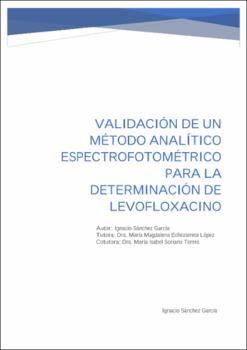Validación de un método espectrofotométrico para la determinación de levofloxacino.
Autor
Sánchez García, IgnacioFecha
2020Resumen
Levofloxacin (LFX) is an antibiotic drug used in many pathologies, including
tuberculosis, and it is marketed in solid oral dosage forms such as tablets or capsules.
Although the method of choice for estimating the amount of said active ingredient is highperformance liquid chromatography (HPLC), the development of alternative or parallel
determination techniques, such as ultraviolet-visible (UV/VIS) spectrophotometry, are of
great interest to reduce not only costs, but also the difficulty of quality control processes
of the pharmaceutical specialties of this drug.
The present study takes as reference different works of validation and of analytical
methods that use the aforementioned technique to the quantitative determination of LFX
in acid solutions with HCl 0.1M as diluent by UV/VIS spectrophotometry. It was
achieved a calibration curve that was statistically studied by an analysis of variance
ANOVA, studies of precision, accuracy, and repeatability. This analysis technique
followed the standards present in the guide ICH Q2(R1) of The International Council for
Harmonisation of Technical Requirements for Pharmaceuticals for Human Use (ICH).
Results: UV/VIS spectrophotometry analysis at a wavelength of 294 nm exhibited a
correlation coefficient of 0.9978 in a concentration range from 2.0 to 9.0 µg/mL. The
equation of the regression curve was y = 0.0864 * x. The average recovery was 100.91%,
while the coefficient of variation (CV) remained at 0.16%. The limit of detection and
limit of quantitation were 0.539 and 1.634 µg/mL, respectively. It was concluded that the
developed method is suitable for the quality control of levofloxacin and it is fast, simple
with high precision and accuracy.





